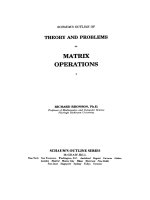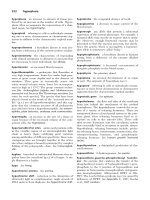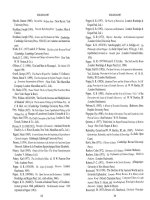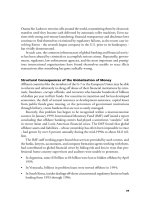schaum s easy outline of principles of economics based on schaum s outline of theory and problems of principl phần 5 ppsx
Bạn đang xem bản rút gọn của tài liệu. Xem và tải ngay bản đầy đủ của tài liệu tại đây (289.86 KB, 15 trang )
Solution:
a. When the MPC = 0.50, the value of the multiplier is 2 [k = 1/(1 −
0.50) = 2]. The multiplier is 4 when the MPC is 0.75 and 5 when it is 0.80.
b. The value of the multiplier is directly related to the magnitude of
MPC, i.e., the greater the MPC, the larger the value of the multiplier.
c. The change in the equilibrium level of output is found by solving
the equation ∆Y = k(∆X
n
) for ∆Y. When MPC = 0.50, the change in the
equilibrium level of output is +$20 [∆Y = 2($10) = $20]. The change in
equilibrium level of output is +$40 when the MPC = 0.75, and +$50 when
the MPC = 0.80.
CHAPTER 5: Keynesian Approach to Equilibrium Output
55
Chapter 6
Fiscal Policy
In This Chapter:
✔ Level of Output with Government
Expenditures or Taxes
✔ Discretionary Fiscal Policy
✔ Built-In Stabilizers
✔ Government Deficit and Debt
✔ Implementing Fiscal Policy
✔ True or False Questions
✔ Solved Problems
Level of Output with Government
Expenditures or Taxes
Taxes reduce personal disposable income and therefore consumption and
aggregate spending, whereas government expenditures increase aggre-
gate spending. The influence of government expenditures and of taxes
upon aggregate spending is shown in Figure 6-1 in the shift of aggregate
spending line (C + I + X
n
+ G). An increase in net lump-sum tax revenues,
ceteris paribus, shifts the aggregate spending line downward to (C + I +
X
n
+ G)Ј, since higher taxes reduce consumer disposable income and
therefore consumer spending at each level of output. An increase in gov-
56
Copyright 2003 by The McGraw-Hill Companies, Inc. Click Here for Terms of Use.
ernment spending, ceteris paribus, shifts the aggregate spending line up-
ward to (C + I + X
n
+ G)Љ. It therefore follows that the government can
alter the economy’s equilibrium level of output by changing its expendi-
tures or net tax revenues. Such government actions are classified as dis-
cretionary fiscal policy.
Discretionary Fiscal Policy
Discretionary fiscal policy involves intentional changes in government
spending and/or net tax revenues in order to alter the level of aggregate
spending. We have already found that an increase in government spend-
ing and/or a decrease in lump-sum taxes shifts the aggregate spending
line upward and raises the equilibrium level of output, while a decrease
in government spending and/or an increase in lump-sum taxes shifts the
aggregate spending line downward and lowers the equilibrium level of
output. The government can use discretionary fiscal actions (changing
government spending and/or lump-sum taxes) to eliminate an inflation-
ary or recessionary gap.
CHAPTER 6: Fiscal Policy
57
Figure 6-1
Important Things to Remember
In the real world, the government may change its
spending and taxing policies for economic reasons
or for purely political reasons.
A discretionary fiscal action has a multiplier effect upon the equilib-
rium level of output. The size of the multiplier depends upon whether
there is a change in government spending, or in net lump-sum tax rev-
enues, and there is an income tax. The value for the multiplier for the
change in government spending is ∆Y/∆G, while the value of the multi-
plier for the change in net lump-sum tax revenues is ∆Y/∆T. When there
is no income tax, a change in government spending has the same multi-
plier effect [k = 1/(1 − MPC)] as does a similar change in investment
spending or net exports. The multiplier is smaller for changes in net lump-
sum tax revenues; the tax multiplier k
t
=−MPC(k) or −MPC/(1 − MPC)
is for an economy with no income tax.
An income tax reduces the value of both the ex-
penditure and the lump-sum tax revenue multiplier
since the amount of taxes paid to government is di-
rectly related to income earned. For example, when
the income tax rate is 20 percent and personal in-
come increases $10, tax payments to the govern-
ment rise $2 and personal disposable income in-
creases $8 rather than $10. Thus, an increase in
personal income results in smaller increments in induced consumption,
and therefore results in a smaller multiplied effect. When there is an in-
come tax, the equation for the expenditure multiplier is k = 1/[1 − MPC
+ MPC(t)], where t is the income tax rate. The equation for the lump-sum
tax multiplier is k
t
=−MPC(k) or −MPC/[1 − MPC + MPC(t)].
Built-In Stabilizers
Personal income taxes and various government transfers automatically
change the level of net tax revenues when the economy moves away (or
58 PRINCIPLES OF ECONOMICS
toward) the full-employment level of output. For example, government
collects smaller revenues from income taxes when output decreases;
lump-sum tax revenues also fall when output decreases because of in-
creased government transfer payments to individuals in the form of un-
employment insurance benefits, food stamps, and other government as-
sistance programs. Because of such automatic changes in net tax
revenues, consumer disposable income is not completely dependent on
the level of output, consumer spending is more stable over the business
cycle, and the amplitude of economic fluctuations is lessened.
Note!
Built-in stabilizers only help to mitigate economic
fluctuations, not to correct them.
Government Deficit and Debt
A federal deficit exists when government outlays exceed revenues. The
structural deficit is the deficit that exists when output is at its full-em-
ployment level; a cyclical deficit is the amount of the deficit that is at-
tributable to output being below its full-employment level. In Figure
6-2, y
f
represents full-employment output. Here the economy’s structur-
al deficit is $200 ($500 in government spending less $300 in net tax re-
ceipts). Note that the deficit increases to $300 when output declines to y
1
,
which is not surprising since there are smaller tax receipts and larger gov-
ernment transfers at output levels below y
f
. Thus, at output y
1
, the $300
deficit consists of a $200 structural deficit and a $100 cyclical deficit.
The public debt is the amount of interest-bearing debt issued by the
federal government at a given point in time and arises from previous year-
ly deficits. Some argue that a large public debt will result in default and
federal bankruptcy. The federal government will not default, however,
since it has the power to print money and the power to tax. The govern-
ment can also repay a maturing debt obligation by issuing a new debt ob-
ligation. However, due to possible redistribution effects, there is concern
about the large increases in the U.S. federal debt. A rapidly rising debt
level necessitates larger interest payments. If the government increases
CHAPTER 6: Fiscal Policy 59
taxes to pay its higher interest expense, it could cause a redistribution of
income from those who pay taxes to those who have substantial wealth.
Important!
There is a difference between the deficit and the
debt. The former occurs yearly and the latter is an
accumulation of the former deficits over time.
Implementing Fiscal Policy
Since discretionary changes in tax revenues and government spending
have a multiplier effect upon equilibrium output, it would appear that
government has the ability to maintain full-employment output by ma-
nipulating its net tax revenues and/or spending. Fiscal policy, however,
is not as easily implemented or as successful as first suggested. Suppose
a recessionary gap exists. Will Congress and the administration agree on
60 PRINCIPLES OF ECONOMICS
Figure 6-2
an immediate course of action? In reality, an action
lag is likely to occur because of conflicting priorities.
For example, some individuals may advocate in-
creased government expenditures on public goods,
such as the rebuilding of roads, while others may pre-
fer government expenditures on services such as public education. An-
other group may advocate expanded welfare services or reduced tax rates
for middle-income workers. And once a fiscal plan of action is reached
and implemented, will Congress and the administration be prepared to
scale down or eliminate any of these measures should the fiscal stimulus
eventually become excessive?
Besides political priorities, we must also recognize that economic ac-
tivity exists in a dynamic, changing environment, where other variables
may change. Thus, while a fiscal stimulus may close a recessionary gap
and bring the economy to full employment, ceteris paribus, it is possible
that investment and/or net export spending may increase after the fiscal
stimulus is implemented, which would result in an inflationary gap. In ad-
dition, economists are uncertain about the output level at which full em-
ployment exists and have been unable to establish precise values for mul-
tipliers for the U.S. economy.
True or False Questions
1. Fiscal policy refers to any change in government tax revenue
and/or in government spending.
2. With no income tax and the MPC equal to 0.80, a $10 increase in
transfer payments shifts the aggregate spending line upward by $8.
3. With no income tax and the MPC equal to 0.75, a $10 decrease in
net tax revenues results in a $30 increase in the equilibrium level of out-
put.
4. When the MPC is 0.75 and the income tax rate is 0.20, the lump-
sum multiplier is −3.
5. The availability of food stamps is an example of discretionary fis-
cal policy.
Answers: 1. True; 2. True; 3. True; 4. False; 5. False
CHAPTER 6: Fiscal Policy
61
Solved Problems
Solved Problem 6.1 How do the following events affect an aggregate
spending line?
a. A $15 increase in government spending.
b. A $10 decrease in investment spending.
c. A $15 decrease in net tax revenues when the MPC is 0.80.
Solution:
a. The aggregate spending line shifts upward by ∆G, the amount of
the change in government spending. In this case, there is a correspond-
ing $15 upward shift of the aggregate spending line.
b. Changes in investment shift the aggregate spending line by ∆I.
Here, there is a $10 downward shift of the aggregate spending line.
c. Changes in lump-sum taxes shift the aggregate spending line by −
MPC(∆T). Since net tax revenues decrease $15, there is a $12 upward
shift of the aggregate spending line [$12 =−0.80(−$15)].
Solved Problem 6.2 Suppose there is full employment at the $600 lev-
el of output and the MPC is 0.80 in Figure 6-3.
a. Does the aggregate spending line (C + I + X
n
+ G) depict the ex-
istence of an inflationary or recessionary gap?
b. What discretionary fiscal action can government implement to
close this gap?
c. What discretionary fiscal action is needed when investment spend-
ing decreases $5?
Solution:
a. There is a $60 inflationary gap since the equilibrium level of out-
put is $660 and full-employment output is $600.
b. Government spending should be decreased $12 since the neces-
sary decrease in aggregate spending is $60 and the multiplier is 5 [∆Y =
k(∆G); −$60 = 5(∆G); ∆G =−$12]. An alternative fiscal action is a $15
increase in lump-sum taxes since the tax multiplier is −4 [∆Y = k
t
(∆T); −
$60 =−4(∆T); ∆T =+$15].
c. The inflationary gap is $35 rather than $60 since the $5 decrease
in investment spending lowers aggregate spending $25. To close the
smaller inflationary gap, lump-sum taxes need to be increased $8.75, or
government expenditures need to be reduced $7.
62 PRINCIPLES OF ECONOMICS
CHAPTER 6: Fiscal Policy 63
Figure 6-3
64
Chapter 7
The Federal
Reserve and
Monetary
Policy
In This Chapter:
✔ Functions of Money
✔ Financial Instruments and Markets
✔ Creation of M1 Money Supply
✔ Federal Reserve System
✔ Monetary Tools
✔ Open-Market Operations
✔ True or False Questions
✔ Solved Problems
Functions of Money
Money serves as a medium of exchange, a measure of value, and a store
of value. As a medium of exchange, money is the payment made to eco-
nomic resources for their services, which the owners of these resources
use to purchase goods and services. For example, labor is paid a money
Copyright 2003 by The McGraw-Hill Companies, Inc. Click Here for Terms of Use.
wage; individuals use this money to purchase food
and clothing. Paper currency and checking ac-
counts comprise the medium of exchange in most
countries. Money serves as a measure of value in
that it is the common denominator for measuring
prices and income. For example, a newspaper costs
$0.50 and workers may earn $9.85 per hour. Mon-
ey functions as a store of value in that the money re-
ceived today can be saved and held for expenditures at some future date.
Financial Instruments and Markets
Savings can be held in financial assets other than money. Since currency
and checking accounts offer savers little or no interest, many savers are
willing to transfer money balances they do not intend to spend for a pe-
riod of time into a higher-yielding financial instrument. A credit or debt
financial instrument is one which requires that a borrower make period-
ic interest payments and repay the amount loaned at the end of a contract
period. An equity financial instrument gives the saver partial ownership
of a firm and a share of its profits.
Many financial instruments are marketable and can be sold to another
party in a secondary financial market. A financial instrument is liquid
when the current owner can quickly convert it into a money balance with
a minimal loss of nominal capital value. A saver therefore has a choice of
holding a liquid financial instrument or money as a store of value. The
portfolio decision of holding money, liquid financial instruments, or illiq-
uid financial instruments depends upon the time horizon of the saver, the
return on these alternative instruments, and the willingness of the saver
to assume risk.
You Need to Know
Savers have a host of mediums in which to store
extra money. We mention some major categories
primarily for information purposes.
CHAPTER 7: The Federal Reserve and Monetary Policy 65
66 PRINCIPLES OF ECONOMICS
Depository institutions (commercial banks, savings and loan associ-
ations, and credit unions) borrow savers’ money balances and lend them
to individuals, businesses, or government. By pooling the funds of many
small savers and investing in a diversified portfolio of financial instru-
ments, these institutions reduce the transaction costs and risks associated
with lending to a borrower. In the U.S., the Federal Deposit Insurance
Corporation (FDIC) insures the liabilities of deposit intermediaries.
Savers therefore readily hold these liquid liabilities because they nor-
mally offer a higher interest return than money. Because the liabilities are
liquid and therefore good stores of value, the Federal Reserve presents an
M1, M2, and M3 definition of money. The M1 definition is a transaction
definition and consists of currency and checking accounts, while M2 and
M3 add other liquid financial instruments to the M1 definition.
Current measures of the money supply appear in Table 7.1. Small
time deposits are certificates of deposit (CDs) issued by these same fi-
nancial intermediaries in amounts less than $100,000, and large time de-
posits exceed this dollar amount. CDs are classified as time deposits since
the depositor agrees to keep these funds on deposit for a specified period
of time or incur an interest penalty. Repurchase agreements (RPs) are
large (at least $1 million) overnight, collateralized loans.
Table 7.1
CHAPTER 7: The Federal Reserve and Monetary Policy 67
Creation of M1 Money Supply
When a bank lends, it gives the borrower a check drawn upon itself. The
Federal Reserve controls the banking system’s ability to issue check-
writing deposits by imposing a reserve requirement on
checking deposits. U.S. bank reserves consist of curren-
cy held by banks and deposits that banks have at the
Federal Reserve. The reserve requirement (r) on check-
writing deposits is currently 10 percent (r = 0.10); it
requires that a bank hold $1 in reserves for each $10 in
checking account liability it has. Since U.S. banks are
managed to maximize profits, they usually expand loans and issue check-
writing deposits when they have more reserves than they are required to
hold. Even when a bank has no excess reserves, it can lend and create new
checking deposits if it can borrow the excess reserves of other banks.
With banks behaving in this manner, there is a tendency for the ex-
cess reserves of the banking system to approximate zero and for the com-
bined sum of check-writing deposits to be a multiple of the amount of re-
serves held by all banks. When excess reserves for the combined banking
system equal zero, the relationship of check-writing deposits (D) and re-
serves (R) can be presented as D
max
= dR, where d, the check-writing de-
posit multiplier, equals 1/r. It therefore follows that the Federal Reserve
can control the maximum amount of check-writing deposits by control-
ling the amount of reserves held by banks and by setting the reserve re-
quirement on checking deposits.
Example 7.1
Suppose the reserve requirement on check-writing deposits is 0.10 and
reserves held by all banks total $500,000. The maximum amount of
check-writing deposits for the banking system is $5,000,000. D
max
= dR;
d = 1/r; d = 1/0.10 = 10; since R = $500,000, D
max
= (10)$500,000 =
$5,000,000.
Note!
Banks are essential to the U.S. monetary system
as the Federal Reserve System can only work
through these businesses.
68 PRINCIPLES OF ECONOMICS
Federal Reserve System
The Federal Reserve System manages the U.S. money supply in order to
minimize inflationary pressures and promote economic stability. The
Federal Reserve System, frequently referred to as the Fed, consists of
twelve Federal Reserve Banks, a Board of Governors, and a Federal Open
Market Committee. The Federal Reserve System is considered indepen-
dent in that its policy directives are not directly influenced by the con-
gressional or executive branches of the federal government.
Federal Reserve Banks. Each of the twelve Federal Banks has its
own president, services banks in a specific geographical area, and acts as
a central bank for that region. A Federal Reserve Bank clears checks be-
tween banks, supervises and regulates banks in its region, performs bank
examinations, provides currency to banks, and holds bank reserves. Pri-
vate individuals and corporations do not deal directly with a Federal Re-
serve Bank.
Board of Governors. The seven-member Board of Governors is the
policy-making body of the Fed. Each member of the Board is nominated
by the President of the United States for a fourteen-year, nonrenewable
term. Because appointments to the Board are terminal and last for many
years, members of the Board of Governors are free of political consider-
ations in the formulation of monetary policy.
Federal Open Market Committee (FOMC). The twelve-member
FOMC is responsible for implementing U.S. monetary policy. It estab-
lishes directives for open-market operations which determine the M1
money supply. The seven-member Board of Governors and five Federal
Reserve Bank presidents comprise the FOMC.
Monetary Tools
The Fed supplies the private sector with whatever amount of currency it
wants to hold—thus, the currency component of the M1 money supply
is determined by the private sector. Monetary tools available to the Fed
include changes in the reserve requirement, open-market operations that
control the amount of reserves held by banks, and adjusting the discount
rate, which may influence the amount of reserves banks borrow from
Federal Reserve Banks.
Reserve-Requirement Variation. A decrease in the reserve require-
CHAPTER 7: The Federal Reserve and Monetary Policy 69
ment on check-writing deposits (monetary ease) creates excess reserves
and increases the amount of check-writing deposits issued by banks. Sim-
ilarly, an increase in the reserve requirement (monetary tightness) de-
creases the check-writing component of M1. While reserve-requirement
variation is a powerful means of changing the M1 money supply, it is used
infrequently. Monetary ease or tightness is usually done incrementally.
Weekly or monthly changes in the reserve requirement are abrupt and
would create management problems for the large number of banks that
exist in the U.S.
Open-Market Operations. Open-market operations consist of the
purchase and sale of government securities (debt obligations of the U.S.
Treasury) by the Fed and are directed by the FOMC. When the Fed pur-
chases government securities, it pays for these bonds by crediting the de-
posit account banks have at a Federal Reserve Bank. Since reserves in-
clude these deposits, such security purchases increase bank reserves and
eventually the amount of check-writing deposits issued by banks. Feder-
al Reserve sales of government bonds reduce bank reserves and check-
writing deposits, and thereby the M1 money supply.
Discount Rate. A bank may borrow reserves (discount) from a Fed-
eral Reserve Bank when it has a reserve deficiency; the rate of interest it
pays the Fed is the discount rate. Banks are encouraged to remedy a de-
ficiency by borrowing the excess reserves of other banks in the Fed funds
market rather than borrow at the Fed. So, the Fed frequently changes the
discount rate after an increase or decrease in the Fed funds rate to en-
courage this practice. Adiscount rate change is newsworthy in that it con-
firms the direction of the movement in the Fed funds rate of interest and
interest rates in general.
Important!
Open-market operations are the primary tool of the
Fed and are used practically daily to accomplish
the Fed’s goals.
Open-Market Operations
A change in the M1 money supply affects the short-term rate of interest
when there is no change in the private sector’s demand for money. There









